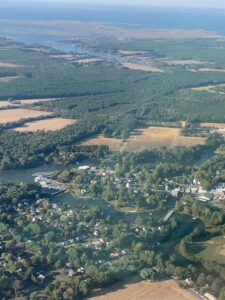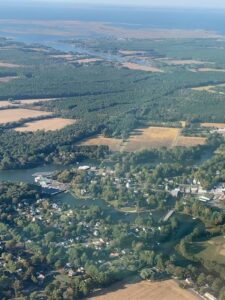 THE COMPREHENSIVE PLAN (2021)
THE COMPREHENSIVE PLAN (2021)
In 2021, the Town Council of Onancock approved a new comprehensive plan. We attach it here. Spend some time on it with an eye towards strengths and weak areas. The town’s Planning Commission is required by statute to author a comprehensive plan.
THE ONANCOCK PLANNING COMMISSION
The Planning Commission is responsible for the Comprehensive Plan (link above). The following paragraph is taken verbatim from the Town of Onancock website:
The Planning Commission is required by the Code of Virginia. Every locality creates a Planning Commission to promote the orderly development of its locality. The Planning Commission is also responsible for the creation of a Comprehensive Plan for the physical development of the Town for the Town Council to adopt. The Planning Commission reviews, discusses, and hears public comment on matters related to town code and ordinances related to zoning and planning. The Commission also makes formal recommendations to the Town Council regarding revisions to the Comprehensive Plan, Zoning Ordinances, Subdivision Ordinances and rezoning requests.
Planning Commission meetings are held the first Monday of every month at 5:30 in Town Hall. We have found that the Planning Commission is not used to having an audience, and its members seem to be fuzzy on the guidelines under which they must operate. At a recent meeting that included a vote on an zoning problem associated with the grounds of the Historic Onancock School, the chair announced at the opening would not take any “public comment.” This seems to be in violation of the town’s own description of how the Planning Commission operates.
Although you may already have enough meetings in your life, we recommend that you consider attending Planning Commission meetings whenever possible.
HOW PLANNING COMMISSIONS ARE MEANT TO WORK
Planning commission duties include an annual report to the Town. It is allowed to recommend ordinances but cannot pass them. The commission reports to the Town Council. Here is the list of its duties taken verbatim from the enabling legislation.
1. Exercise general supervision of, and make regulations for, t he administration of its affairs;
he administration of its affairs;
2. Prescribe rules pertaining to its investigations and hearings;
3. Supervise its fiscal affairs and responsibilities, under rules and regulations as prescribed by the governing body;
4. Keep a complete record of its proceedings; and be responsible for the custody and preservation of its papers and documents;
5. Make recommendations and an annual report to the governing body concerning the operation of the commission and the status of planning within its jurisdiction;
6. Prepare, publish and distribute reports, ordinances and other material relating to its activities;
7. Prepare and submit an annual budget in the manner prescribed by the governing body of the county or municipality; and
8. If deemed advisable, establish an advisory committee or committees.
Planning commissions are advisory; they cannot add zoning ordinances to local codes, for example. They do have the ability to create advisory groups. They also “may cooperate” with other planning commissions in the area to advance coordinated planning. For example, the Onancock’s Planning Commission could work with the commission for Accomack County on issues that affect us beyond town borders. The state code allows one planning commission member to be on the planning commission of a “contiguous locality,” so a member of our commission could be appointed to serve on the county commission — not a bad idea in an era of local growth.
Onancock Planning Commission members have to live within the town borders. At least one half of all members have to own real property in the town. There is room for the voices of people who are local renters, which could allow more variety in the voices representing the town.
Members are required to attend meetings and can be removed for absenteeism. Missing three consecutive meetings, or four meetings over twelve months is grounds for removal and replacement by the Town Council.
Planning commission records are required to available to the public. This includes minutes and other advisory documents.
Regular and special meetings. Planning commissions are required to meet at least every two months — except in small towns of under 7,500. Theoretically, our planning commission could meet only once a year and meet the statute’s requirements. Some small towns designate their county planning commissions as their own; this is allowed under the statute.
Planning commissions can have a budget. The “governing authority” (the Town) would provide this. Funds can be used for consultants, special surveys and other purposes associated with planning. The records of expenditures have to be made public.
Planning commissions are required to create a comprehensive plan for their communities. The scope of comprehensive plans is quite large, and you will want to look at that section of the legislation for more detail. Here we call your attention to five areas that we think are particularly important at the present (and that may not have been treated in enough detail in the 2021 plan).
- The comprehensive plan must include discussion of community resilience from hazards such as damage associated with weather.
- The comprehensive plan must include “designation of areas and implementation of measures” associated with affordable housing in our town. The needs of “current and future residents of all levels of income” must be included.
- The plan must include a “transportation plan” that actually includes things like bicycle and pedestrian “accommodations.” Onancock’s needs are less complex than large cities, but wide, safe sidewalks in all our neighborhoods are certainly part of the mandate to serve the needs of residents in low-income housing and people who cannot or will not drive automobiles.
- Throughout the statutes, the phrase “the elderly and persons with disabilities” appears repeatedly. Onancock has a thriving population of seniors, and a smaller population of people with disabilities. The particular needs of these folks should be considered as fundamental to any comprehensive plan. (Curb cuts are already part of the sidewalks in the central part of town.)
- Each plan must include a “designation of community service facilities” that includes both public and private institutions. Arts organizations are not listed explicitly in this list, which includes “parks, sports playing fields, forests, schools, playgrounds, public buildings and institutions, hospitals, nursing homes, assisted living facilities, (and) community centers.” Arts groups seem to be folded into “public and private institutions.” With increasing development, extra care should be taken to maintain public outdoor spaces within the town through such measures as zoning.
Below is the link for the enabling legislation for Local Planning Commissions.
https://law.lis.virginia.gov/vacodefull/title15.2/chapter22/article2/